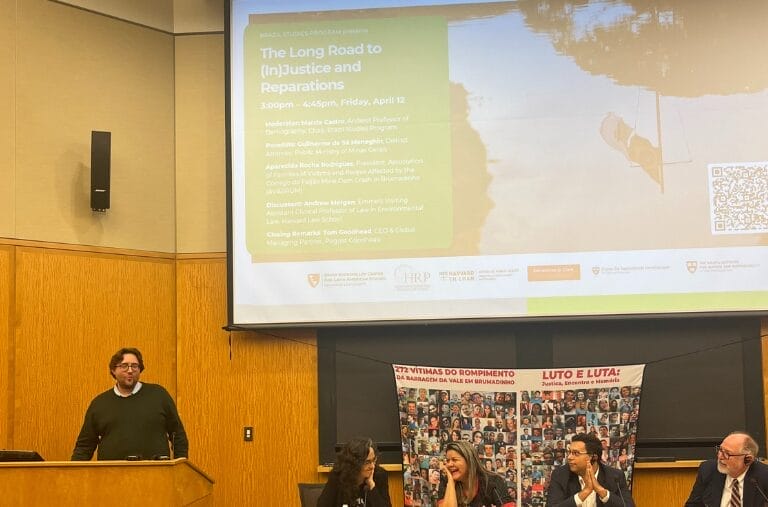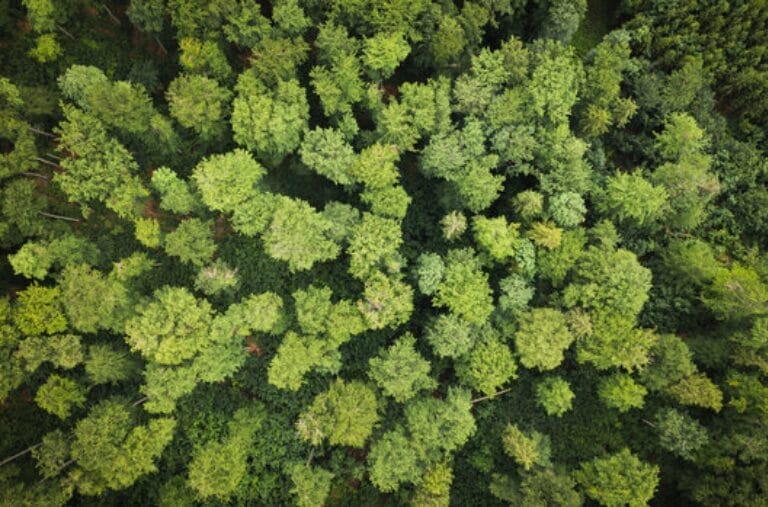Pogust Goodhead has a direct interest in Rights of Nature because of its experience in representing indigenous communities and people, its interest in developing the boundaries of the law, and its commitment to using litigation to address the climate crisis.
Pogust Goodhead is also exploring how to introduce Rights of Nature to litigation, both in Latin America in relation to forests and in England & Wales in relation to rivers, and to that end is grateful for the collaboration of Lawyers for Nature, the Environmental Law Foundation and Dr Joanna Smallwood, among (many) others.
But what does ‘Rights of Nature’ mean? What do we mean when we say ‘nature’, or talk about its ‘rights’, where do they come from, and why are they important?
In the hope of sharing something useful on the extensive topic of Rights of Nature, this post has three goals:
1.To be Pogust Goodhead’s contribution to the conversation around Rights of Nature. The conversation is growing in publicity: a 10 October 2022 report by the Law Society, “Law in the Emerging Bio Age”,[1] argued that legal rights should be granted to non-human entities, and the arguments for Rights of Nature was featured in an April 2022 article in the New Yorker[2] and there are a range of events at and statements made about COP 27 to which rights of nature is relevant.[3]
2.To summarise Rights of Nature with a focus on indigenous communities and people
3.To present Rights of Nature as an important and accessible tool for changing consciousness and addressing the climate crisis.
Legal Rights of Nature initiatives are growing globally, with recent examples including deforestation in Ecuador halted for breach of nature’s rights[3a] and the Whanganui River in New Zealand being granted legal personhood.[4]
The power of these initiatives rests, at least partially, in their potential to change the way that people think.
What is ‘nature’?
There are two ways to answer this question, depending on whether it is asked within an anthropocentric or ecocentric framework:
1.Anthropocentrism
Different elements of nature have different values depending on their use as a resource to maintain or improve human wellbeing, for example as food, water, air, companionship, entertainment, building materials, protection from natural disasters, etc.:
“People who are strongly anthropocentric care only about the welfare of humanity; all other species are resources to be exploited. They would be content in a world dominated by domestic species as long as there was sufficient food, water, and oxygen and whatever other elements of nature are necessary to provide people with healthy, happy lives.” (Hunter M et al, 2014)[5]
This framework often closely relates the environment to human rights. It also grants rights to other species depending on their value to humans. The anthropocentric justification for Rights of Nature includes the obvious point that if there was no nature, we would not exist: we cannot live without plants, water, or air.
2.Ecocentrism
Nature has inherent value independent of its value to humans, and is an indivisible whole. Humans are a part of nature, not apart from it.
This framework does not grant rights so much as acknowledge that they already exist. This framework also compares to human rights in that they are based on recognising rights which are fundamental and inalienable.
(It is generally useful to have these frameworks in mind when analysing any initiative that claims to realise Rights of Nature – for example, “nature-based” solutions often sit uncomfortably between the two. [6])
The philosophy of Rights of Nature, also called “earth jurisprudence”,[7] is fundamentally ecocentric. (The practice does vary, and this distinction is explored later in this post.) This means that granting rights to other entities is not directly what Rights of Nature is about – that is simply a natural consequence of realising Rights of Nature.
Humans and their rights are not separate from the environment and its rights, because there are no elements of nature which are separate: everything is one connected whole. Ecological destruction is the natural consequence of not realising Rights of Nature, and believing that humans are separate from nature.[8]
Rights of Nature is, therefore, about inherent value, and the unity of that value. With reference to Ronald Dworkin, it is something that hedgehogs know, not foxes.[9] This is why it appears, directly or indirectly, in everything from the 2021 The Economics of Biodiversity: the Dasgupta Review,[10] legal academic curricula, books on “green capitalism”,[11] speeches by the pope[12] and the UN Secretary General,[13] to transcendentalism and the “over-soul” of Ralph Waldo Emerson’s poetry, TED Talks on the right side of the brain,[14] and ancient Celtic myths and traditions.[15]
This universalism means that it includes scientific and economic explanations of its foundations for the spiritually sceptical.
Each circle’s existence relies on both the maintenance of its rights and the existence of the circle that encompasses it, if there is one. Without the maintenance of nature’ rights, the whole structure within which humans and our economy collapses. This image also begs the question why elements of the inner circle, such as companies, have been granted legal personhood when the more tangible and essential encompassing whole has not.
With the above definition of nature in mind we can consider what rights it might have.
What rights?
The United Nations Harmony With Nature website maintains two web pages listing the wide range of law and policy instruments at local, national, and international level.[17] These instruments vary considerably in influence and fame,[18] as well as scope, detail, and content, with topics important to some but entirely absent from others, including nuclear power, climate change, capitalism, and feminism.
Further, what features they have in common tend to be expressed in nonspecific, even spiritual language: for example, the Universal Rights of Rivers declares that rivers have the right to be free from pollution, to flow, and to regenerate and restore, rather than to exist in a particular scientific state or have a specific content.[19]
Nevertheless, there are critical commonalities between declarations.
First, all instruments centre around nature’s right to exist. The inherent nature of this right is the reason that the language of declarations – what might appear at first to be a lack of specificity – is deliberate and central to Rights of Nature.
A universally agreed state of existence for nature is not a prerequisite for realising nature’s right to exist, and such an agreement would in fact be contrary to nature’s variance and relationships.
There are also important practical commonalities. The most practically successful instruments are generally set out in written constitutions or legislation, and often relate or evoke the spiritual or special significance of nature.[20] Here, the use of spiritual language – possibly not familiar or comfortable to lawyers – has practical effect.
These practical considerations also highlight the distinction between the philosophy and practice of Rights of Nature, in turn highlighting a critical point about all declarations of Rights of Nature: they all vary in position on the anthropocentric/ecocentric spectrum.
A simple example demonstrates how this variance is possible: law declaring that a river has rights because it is a special river (to humans) is different from law declaring that a river has rights because it is a river.[21] In order to understand the implications of the distinction between Rights of Nature in thought and in action, we should explore its history.
Where do Rights of Nature come from?
Again there are multiple ways to answer this question. For reasons of space and Pogust Goodhead’s experience, this post briefly considers three, which all relate to each other, indigenous communities, and people.
First, the practical answer.
50 years ago, the late Christopher Stone, who died last year, published the book Should Trees Have Standing? He argues that the answer to his question is “yes”, and that this answer would reflect a “radically different law-driven consciousness.” The interesting and entertaining genesis of the book was set out in an April 2022 New Yorker article on the (later unsuccessful) attempt by a lake in Florida to prevent a planned development on the basis that it would injure the lake.[22] The article states that,
“The notion that “natural objects” like woods and streams should have rights was first put forward half a century ago, by Christopher Stone, a law professor at the University of Southern California.”
This is not strictly true, which leads to the second and philosophical answer to the question. As Craig Kaufmann and Pamela Martin observe, and as signalled above, Rights of Nature can be divided into (1) the philosophy that nature is one interconnected whole with inherent value, and (2) the practical attempts to realise that philosophy in law.[23] Should Trees Have Standing? is an attempt to realise that philosophy.
It did not invent it. Similarly, although Stone is rightly credited, alongside Cormac Cullinan, with Rights of Nature’s modern revival in the West, he did not invent the argument that the philosophy could or should be put into practice. Both the philosophical and practical elements of Rights of Nature are often associated with indigenous communities, and, as Cullinan observed while researching Wild Law, a book which both argues for and explores the history of Rights of Nature, he consistently came across “recurrent themes” other people and cultures, modern and historical, who had independently realised earth jurisprudence.[24]
This brings us to an important moral challenge for Rights of Nature: properly recognising and crediting the role of indigenous peoples. This lack of recognition is unfortunately not uncommon: indigenous cultures are not seriously considered in Should Trees Have Standing?, and as above the New Yorker credits Stone with inventing Rights of Nature, despite the article include an interview with an Ecuadorian lawyer who states that “… the philosophical concept behind the rights of nature fits into the vision of [Ecuador’s] Indigenous peoples. That’s why you find the words Pacha Mama in the constitution.”
This lack of recognition has practical consequences – for example, Roderick Nash’s The Rights of Nature: A History of Environmental Ethics (1989) includes the bizarre and offensive implication that colonialism was responsible for introducing and granting rights to its victims.[25] It is also important to prevent the West from being credited with the invention of a philosophy commonly associated with cultures it has a history of deliberately destroying.
Further, recognising indigenous communities must take place while not representing[26] them, and acknowledging that their existence and values pre-date their representation as “indigenous.” It is critical not to say simplistically that all indigenous cultures are the same, all indigenous cultures have Rights of Nature, or that the word “indigenous” is uncomplicated. Finally, to add to the challenge, it is fundamental that this recognition takes place alongside ensuring that Rights of Nature are available to everyone, i.e., they are not exclusive to indigenous communities.
A possible solution to this challenge comes via considering the colonial context to the question as part of the third, historical answer.
The history of Rights of Nature in the West since Magna Carta is examined by Nash in The Rights of Nature: A History of Environmental Ethics. Nash argues, among things, that the question where do Rights of Nature come from is part of the greater question where do rights come from, or where does law come from; that the answer to this question used to be, God; and that the decline of religion meant that the question was re-asked. When it was re-asked in Eighteenth-century England it seriously included the anthropocentric vs ecocentric debate but, in short, anthropocentricity won, and the answer became: rights come from being a human. Or rather, from being a certain type of human: a “civilized” man (white, European). At the same time as the anthropocentric vs ecocentric debate, the more general European debate where law comes from was taking place as part of the justification for colonialism and the deliberate obliteration of the legal systems of “uncivilized” peoples.[27] What this means is that colonizers assigned themselves the role of determining the anthropocentric v ecocentric debate, and then imposed the results of that debate worldwide.
This historical viewpoint allows us to return to the re-consider what we mean by “indigenous”, and the following definition:
“Generally, indigenous peoples have a deep-rooted and often spiritual relationship with the land on which they live and with the natural resources that they use. For such peoples land and resources are not merely property and means of production, but the very basis of their existence, traditions, and beliefs.”[28]
Since each relationship is with “the land on which they live [and] the natural resources that they use”, they must vary as land and resources change. There therefore is a common framework for a relationship with nature which varies in practice according to context: universal values with unique realisations. There do exist cultures which are ecocentric, there used to be more until those communities were deliberately obliterated, and ecocentrism can be found in the history of both colonising and colonised countries. Ecocentrism exists now only at the fringes of society but used to more prominent. This makes realising Rights of Nature an act of repair and restoration as well as an act of creation.
This is why it is possible for Cullinan to make general statements like “most of the ideas that you will find in [Wild Law] have been expressed in different contexts and ways by many people over thousands of years”[29] and why he refers to rights of nature existing in the “zeitgeist.” The basic premise of Rights of Nature reveals itself whenever a person or community communes closely with the rest of nature. Rights of Nature is not just for people who live closely with the land. It is for everyone, including people who feel or want a close connection with the land, regardless of whether or how they live, and people who care about the climate crisis.
Why are Rights of Nature important?
Climate change is an existential crisis operating at every scale of our lives. It affects us globally and locally, and affects all manner of decisions – whether to have children, where to live, what to do as a job, and how to vote, travel, and consume, and affects and will affect borders, housing, identities, families, economies and countries. This existential nature makes a neutral position impossible – inaction is an activity in favour of climate change.
This gives us a rational and moral duty to do something about it, which can be empowering or not: faced with the scale of the crisis and this duty, it can be dispiriting to have relatively little agency or power. You may believe that a great deal of things can and should be done but not be in a position to effect any of them.
Fortunately, agency is irrelevant to the ability to understand Rights of Nature or promote it to peers. This is because Rights of Nature is about changing consciousness, and responding to the climate crisis involves changing the way that we think, as acknowledged by the European Bank of Redevelopment[30], Christiana Figueres[31], the IPCC Sixth Assessment Report,[32] and Sir David Attenborough.[33] If the tipping point for social convention is 25% of a population believing in a particular cause, then you can be part of that critical minority and so can anyone you speak to.[34]
Lawyers have a role to play in society reaching this tipping point. The law has a normative role in changing how we think,[35] in forming societal values[36] and setting behavioural benchmarks,[37] and so the law is important to realising Rights of Nature. I would therefore encourage lawyers reading this to reflect on the ways in which their practice creates the future, in particular as part of the public conversation the profession was recently invited to by Professor Steven Vaughan.[38] More fundamentally, though, all people have a role to play because rights of nature is about values. It is not so much about a legal document or decision stating that, for example, a river has rights, but the values which created and are expressed by that law.
Finally, the creative side of Rights of Nature allows for positive rather than purely negative responses to the climate crisis. It allows us to talk about what we should do rather than what we should not, and to discuss the future in terms of fundamental values in addition to action. For example, in a recent interview Beaska Niillas, indigenous activist and politician (among other things), was asked what measures he could speak out in favour of, rather than simply criticising various attempts to address climate change. In response to, “If that is the no, what is the ‘yes’ that you might work towards?”, he said:
“…I don’t think that’s a fair question to put to an Indigenous nation. We have always been here. […] The land is for loan. You take care of the land, the land will take care of you. […] So I would like to say yes to survival, yes to culture […]. And that’s – then we are talking about values. What is really precious in life? What is really precious for our people, what is precious for the world?” [39]
Consequently, the conclusion leads us back to the beginning. The answer to the question of why Rights of Nature are important, it is because of its inherent value. If we say yes to thinking differently, to thinking ecocentrically, what to do will follow naturally.
References [1] Give legal rights to animals, trees and rivers, say experts | Environment | The Guardian; Law in the emerging bio-age | The Law Society [2] A Lake in Florida Suing to Protect Itself | The New Yorker [3] This relevance is not new – rights of nature has always been relevant to climate change. However, COP 27 follows one which was the first to nominate indigenous peoples to various advisory roles (COP26 Strengthens Role of Indigenous Experts and Stewardship of Nature | UNFCCC), and there are a range of events planned which relate to nature-based solutions, rights-based approaches, and nature as the foundation for human and global security. COP27’s host website lists four goals – mitigation, adaptation, finance and collaboration – the latter of which states that “[e]nsuring humans are at the center [sic] of climate talks is imperative.” A rights of nature rewording would talk about ensuring that nature is centre of climate talks. [3a] Plans to mine Ecuador forest violate rights of nature, court rules | Ecuador | The Guardian [4] The New Zealand river that became a legal person - BBC Travel [5] Credit and thanks to Dr Smallwood for this summary and quotation. [6] Nature-based Solutions | IUCN [7] This phrase is used by Cormac Cullinan (Wild Law) and taken from Thomas Berry. [8] For the links between this belief and capitalism see, e.g., the work of Jason Hickel and most recently The Value of a Whale: on the illusion of green capitalism by Adrienne Buller. [9] Ronald Dworkin, Justice for Hedgehogs. [10] The Economics of Biodiversity: The Dasgupta Review. “Nature is more than a mere economic good. Nature nurtures and nourishes us, so we will think of assets as durable entities that not only have use value, but may also have intrinsic worth.” [11] Buller, The Value of a Whale, 2022, p.28, 140, 249, 252, 258, 266. [12] Integral human development in harmony with nature | WWF [13] Create conditions for ‘harmony between humankind and nature’, UN chief says on sidelines of G20 in Japan | | 1UN News As Craig Kaufmann and Pamela Martin observe, “harmony with nature” is generally taken to be a euphemism for rights of nature. [14] Jill Bolte Taylor: My stroke of insight | TED Talk [15] Miranda Aldhouse-Green: The Celtic Myths: A Guide to the Ancient Gods and Legends, 2015, pp. 15, 41, 156, 162; Sacred Britannia: The Gods and Rituals of Roman Britain, 2018, pp. 110, 111; 2021, pers. comm. [16] Nature's Rights | Transform the System (natures-rights.org) [17] harmonywithnatureun.org [18] One of the most influential modern declarations on rights of nature is the Universal Declaration of the Rights of Mother Earth, drafted on 22 April 2010 at the World People’s Conference on Climate Change and the Rights of Mother Earth, Cochabamba, Bolivia.[18] The conference was attended by around 30,000 people and the drafters included Cormac Cullinan, the author of Wild Law. [19] Rights of Rivers [20] E.g., the Ecuadorian constitution. [21] E.g., the Whanganui River. [22] A Lake in Florida Suing to Protect Itself | The New Yorker (ampproject.org) [23] Kaufmann and Martin, The Politics of Rights of Nature, 2021. [24] Cullinan, Wild Law, p.93. [25] Nash depicts the evolution of rights in America as an expanding fan, including granting rights to former enslaved people by the Emancipation Proclamation of 1863 and to Native Americans by the Indian Citizenship Act 1924. This obscures the reality that enslaved and indigenous people held rights which were taken away by slavery and colonization; the correct shape is not a fan, but an hourglass with colonization at the pinch. [26] “Representation” as in the postcolonial critical concept: Ashcroft B, Griffiths G, & Tiffin, H 2013, Post-Colonial Studies: The Key Concepts, 3rd Edition, “representation” <https://learning.oreilly.com/library/view/post-colonial-studies-the/9780415661904/006_9780203777855_chapter1.html> [27] Anthony Anghie, Imperialism, Sovereignty, and the Making of International Law [28] Kälin and Künzli, ‘The law of International Human Rights Protection’, European journal of international law, 21(1), 245-246 [29] Cullinan, Wild Law, p.12. [30] 2019, the year the world woke up to climate change (ebrd.com) [31] Figueres & Rivett-Carnac, 2020: 15 [32] March 2022. The report acknowledges the power of changing consciousness and consciousness-raising [33] (Our Planet | Groundbreaking Series) “How do we create a future in which both people and nature can thrive? We open our eyes to this moment in history. Think on a planetary scale.” [34] Experimental evidence for tipping points in social convention | Science, as referenced in After the failure of Cop26, there’s only one last hope for our survival | George Monbiot | The Guardian [35] The Legally Disruptive Nature of Climate Change, 197-198 [36] Cullinan, 2011: 55). [37] Allot, 1990: 298. For example, in September 2015 Philippe Sands QC summarised recent developments in environmental protection, concluding that “there has been some change of consciousness”, citing as an example a ban on scientific whaling which led to a company the next day announcing that it would no longer hunt whales for food. Climate Change & Rule of Law: Lecture by Philippe Sands QC chaired by Lord Carnwath, UKSC, 17.09.15 - YouTube [38] Climate Change and the Rule of Law(Yers): What Thinner and Thicker Accounts Might Require of Those in Practice by Steven Vaughan :: SSRN [39] c8d740_d092b20e72074cc59313ed1dc4030857.pdf (upstreampodcast.org) (transcript)









